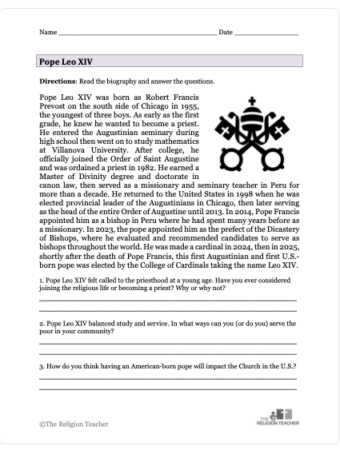Students talking out in class can be one of the most frustrating challenges teachers face on a day to day basis. Whether it is whispering to their neighbors or blurting out questions or comments without a hand raise, talking can be a problem. Usually it is the same students causing the problems day after day who quickly become the thorn in your side.
What are your best practices for eliminating talking out while encouraging effective class discussion?
Classroom Management and Talking Out
Here are the techniques and strategies that I have found most effective in managing talking out in the classroom. I offer them as my suggestions, but what have you found to be most useful?
1. Bell Work – I may sound like a broken record when I talk about bell work, but it is so effective. Have an assignment ready to go as students walk in to keep them busy and focused. Otherwise, they will come in and begin a conversation that they will try to extend throughout the class.
2. Assigned Seats – I’m a big advocate for assigned seats, especially during the first weeks of school. As you get to know your class there are certain students who just cannot sit next to each other. Why tempt a student by sitting them next to their best friend (or worst enemy)?
3. Adjust Seating Arrangements – Sometimes you can’t avoid two talkative people sitting next to each other. Give the students a warning and then move their seats if they continue to talk.
4. Do Not Respond – When a student asks innocently, “What’s you’re favorite movie?” it can be hard not to respond. Don’t engage in the conversation. If you acknowledge the comment of a student talking out, then you reinforce the behavior. Train yourself not to engage in conversations that students try to initiate without raising their hands.
5. Enforce the Rules – If “Raise your hand” is a classroom rule, then it has to be enforced. Don’t think of it as a “lesser” rule. If you have to give a detention for talking out, do it. It is the only way you will reinforce the behavior for the student and their peers. You must also enforce the talking out rule for students who rarely make the mistake. If you don’t warn or punish a student who seldom talks out, the talkative student will be enraged at the injustice. Kids have a strong sense of justice even when they are punished often.
What are your best strategies for managing talking out in class? Post your ideas in the comments at the bottom of this page.
Update: There is a great discussion over at Google+. Check out Isolde Eleison’s thoughts on the “Love and Logic” Approach. It is fascinating: https://plus.google.com/100247560868840972812/posts/RG88ZZwfgUY



Thanks for sharing these Jared. It’s a challenge to manage talking out in class. You give some good tips.
Thanks for another great post Jared. I agree that bellwork is a great way to get them settled quickly. When they don’t have any, it definitely takes a lot longer for them to sit down and be quiet. Thanks for the reminder. It takes a little more time to come up with a journal question or quick worksheet but it is worth it! Also, one thing I’ve done this year is have a “focus” folder ready in the front of the room. It has some great catechism worksheets I found online and printed, as well as a few ideas for a “whole class” assignment (write a one page paper on The Church Militant, Penitent and Triumphant, or the History of the Rosary.) I have found that just having it at the ready does the trick.
You can find the catechism worksheets here (You’ll LOVE them!): http://www.rc.net/lansing/ctk/rcia/
Oh Yeah, I forgot to mention it, but the “Focus Material” is homework. I tell students that if they take my time, I’m going to take theirs….
I am a student… I don’t know how I got on here but, my class talks alot. My religion, science, and spanish teacher ALL do bellwork. I t does help my class quiet down at the beggining of class. My math teacher says everytime she hears a voice when we are NOT supposed to be talking, we get 5 extra ?s of homework. It really helps my class quiet down. This extra homework ?s is like the “Focus Material.” I think my teachers get these ideas from this website. If they do… you REALLY help them.
Wow, thanks Hannah! I’m so glad to hear the positive feedback from an actual student.
You can also try positive reinforcement.
Criterion-specific rewards can be used as part of a proactive intervention for managing classroom behavior. Students may earn criterion-specific rewards such as activities, privileges, and tangible incentives after the occurrence of an identified target behavior(s) at a set level of performance.
A group contingency is a group reinforcement technique that capitalizes on peer influence by setting a group goal and/or implementing a group consequence for behavior. The purpose of this strategy is to prevent behavioral problems, increase appropriate behaviors, and/or to decrease incorrect behaviors, depending on how the contingency is engineered.
*There are also games that promote good behavior.
http://catholicblogger1.blogspot.com/2011/05/good-behavior-classroom-strategies.html
Thanks for sharing the link to the games (your games are awesome!). I’m a big proponent of positive reinforcement as well. All too often the students who get in trouble the most, crave that positive reinforcement because they almost never get it.
If a student acts up enough to be a problem I get right down in his face and nicely say, “You know I said you don’t have to pay attention, but you can’t disrupt the other kids’ learning, right?” Uh-huh. “OK then, if you disrupt class again I will send you to the office for the rest of class, and during pickup I’ll speak to your parents about your misbehavior.”
Between my assistant and me, in eight years we’ve had to go beyond this warning with only 3 individuals that I can remember. In the last three years everyone has been well-behaved. One child slept some last year, but they are tired at 6:30-7:30 pm on a schoolnight.
This is such a “biggie” for teachers, isn’t it? It drives me BANANAS when people talk while I’m talking, but I have to admit that my classroom management often lends itself to side discussions…by which I mean…classroom management is not my forte, some days. However, I find that building in time during class when kids are SUPPOSED to talk to one another, whether in pairs or in small groups, helps quite a bit. They know they won’t be sitting there listening to me blab for the entire class period, and I can say “you guys are doing a great job of following along, now just hang in there another 10 minutes and then you’ll be working in pairs.”
Great ideas here. I like to include an agenda to let them know when they will be able to talk and discuss with one another. Ten minutes is a good rule of thumb for switching activities and approaches. I have heard that a student’s attention span in minutes equates to the grade they are in (so a fifth grader can only focus on a lecture for five minutes).
Talking out can arise out of genuine interest in the topic such as homework or project. Sometimes there are students whose brains work faster than others in the questions department (I’m one of them) so after asking students to be patient when I am explaining a project, I instruct them to write down their questions while I’m talking and cross out the question when during my presentation/explanation, the question is answered. In the end, students learn that most of their questions, if not all, are answered without having to interrupt. Writing things down also helps them focus on the presentation.
Love this strategy Sr. Lovina! Thank you so much for sharing it.
Thank yuo all who have shared yuor ideas. Hope to share next time. GodBless us all
When a student starts to chat w/ their neighbor in class, I stop talking. I wait until the person talking only hears their own voice. They usually stop. I then re-emphasize the class rule of only one person talking at a time.